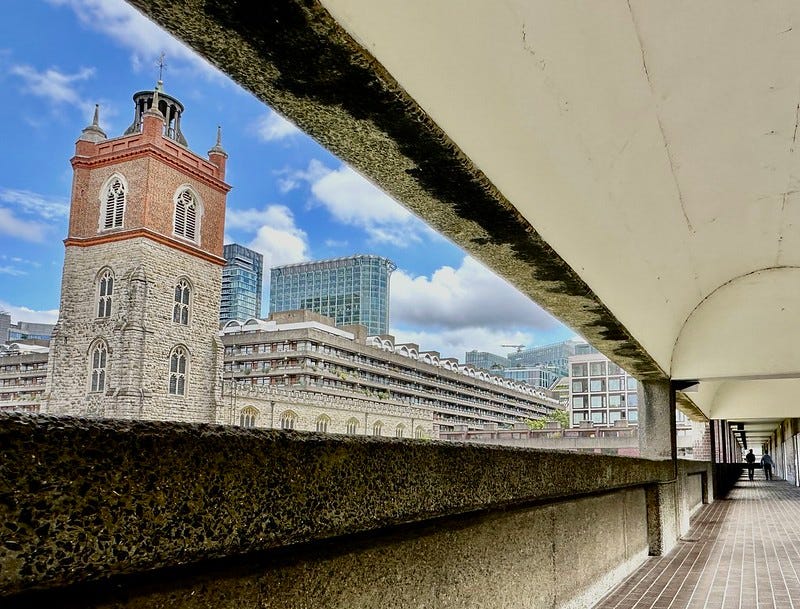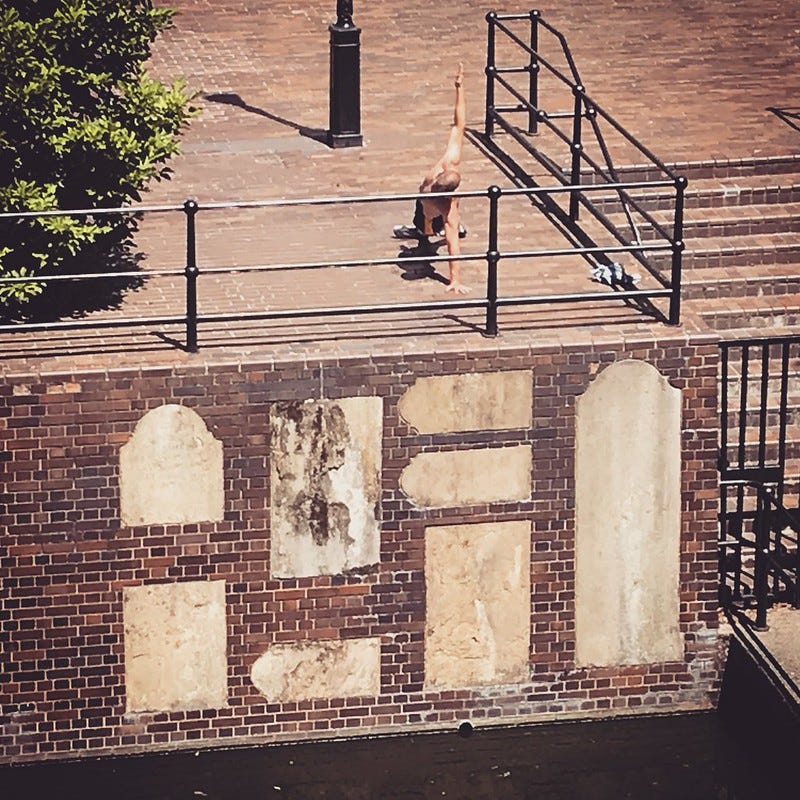Welcome to your Friday newsletter for paying subscribers, with a generous teaser for everyone else.
After covering the city’s pedways (raised walkways) in a recent newsletter, it occurred to me that I’d said very little about the Barbican complex — the 60s brutalist mega-estate where cars are banished underground and the pedestrian reigns supreme. Its 40 acres are almost entirely a post-war creation of concrete and glass, but here and there some history lurks. In today’s short article, I’d like to indulge in some antiquarianism to go with the brutalism.
That’s for the main newsletter. First, a quick announcement and the History Radar of upcoming events.
🍺 MEET-UP: Want to meet me and other history buffs in an historic pub for a bit of a natter? We’re getting together in central London on the evening of Wednesday 11 September. The gathering is open to paying subscribers (and plus-ones). If you’re interested, email me on matt@londonist.com and I’ll reveal the location (when I finally decide!).
History Radar
Upcoming events for London history fans.
🐑 LAMBETH HERITAGE FESTIVAL: A staggering number of historically minded walks and talks are taking place in Lambeth throughout September. Everything from lost rivers to cemetery tours to open days at Brixton Windmill. Take a look through the bursting programme, which sadly only seems to be available as a PDF.
👩🌾 BLOOMSBURY WOMEN: Celebrate the paperback release of Katy Hessel’s The Story of Art Without Men at the Garden Museum in Lambeth. The event on 10 September coincides with current exhibition, Gardening Bohemia: Bloomsbury Women Outdoors, and sees Hessel in conversation with writer, fashion critic and art curator Charlie Porter, and radio host and gardener Flo Dill to talk about gardening, music, culture and the groundbreaking women of the Bloomsbury Group.
🪙 UTOPIAN BLOOMSBURY: Regular readers might recall our recent article about Thomas Spence, the 18th century radical who helped spread his ideas by doctoring coins and throwing them out of his Holborn window. The Infinite City author Niall Kishtainy is at LSE on 12 September to speak at length about Spence, and other radical figures from the local area.
⛪️ OPEN HOUSE LONDON: It's the most wonderful time of year! All manner of London buildings and structures, which are usually off-limits to the public, fling their doors open and welcome us in for Open House London, from 14 September. This year's programme includes the usual diverse mix of modern offices, livery halls, skyscrapers, churches, and other motley edifices -- some require booking in advance, and others you can just drop in and see.
🚇 HARRY BECK: Also from 14 September, London Transport Museum's Cubic Theatre hosts a new play, The Truth About Harry Beck, which delves into the life and work of the creator of the tube map, and his wife Nora. Find out how the world-famous tube map was created, and to what cost.
🛞 FREE ROUTEMASTER RIDES: As part of the national Heritage Open Days programme, free rides on vintage Routemaster buses are being offered on two south London TfL routes on 14 September: the 61 between Bromley and Chislehurst, and the 261 between Lewisham and Locksbottom in Bromley. There's also an open day at Bromley Common Bus Garage (small charge for that one).
🎧 PODCAST OF THE WEEK: The Ladies Who London are back after a summer pause, and my golly gosh is it a good episode. Alex and Fiona are joined by Joe Fuller, one of five engineers responsible for keeping London’s gas lamps burning. Joe is himself a lambent source of trivia about the capital. We learn why most of Westminster’s street furniture is black, London’s most easterly gas lamp, and why nobody balances ladders agains the those sticky-outy handles you see at the top of gas lamps any more. Superb stuff. (Link goes to Spotify, but the podcast is available on other common platforms.)
Reflections on the Barbican
A wagtail bobs across medieval stone. Hoverflies tango with teasel. A pea-green lake wobbles in the wind. Brimstone butterflies, fox turds, a transmural meadow. None of these pop into the mind when somebody says that loaded word: “Barbican”.
The 40 acre estate on the norther edge of the City is more often noted for its megatons of concrete, its brutalist towers and its labyrinthine highwalks. It arose in the 1960s from one of the most heavily bombed parts of London. To see how scarred this place was, just watch the curiously unplugged Unit 4+2 in this 1965 promo video for Concrete and Clay. And remember, this is more than 20 years after the Blitz.
Virtually nothing remains of the area from before the war. The Barbican complex was a fresh start, a tabula rasa. It wiped away almost everything that the Luftwaffe had not already shattered. But not quite everything. Here and there, historical artefacts remain, often protruding from patches of meadow or pendant ivy. Let’s go in search of the ancient Barbican.
St Giles Cripplegate
St Giles-without-Cripplegate is the most obvious pre-war survivor. Its stone is of a similar hue to the surrounding concrete blocks. What a tease on the eye; chromatic concord with architectural discord. And, oh dear, I seem to have slipped into pretentious twaddlespeak already.
The ‘without’ part of the church’s name originally meant ‘outside’ — outside the Cripplegate, which was one of the ancient portals into the city. The gate is long vanished, and the term ‘Cripplegate’ rarely used. St Giles is now without Cripplegate in more sense than one.
The church we see today is something of a mish-mash. It was, of course, badly damaged in the Blitz and had to be rebuilt. However, large chunks of the stonework are Tudor or even medieval. Oliver Cromwell was married here. John Bunyan worshipped here. John Milton is buried here. And, so far as I know, it is the only London church with a stained-glass window that features a skyscraper:
I do like this window. Look closely and you’ll see an anachronism. The mid-ground shows the old Cripplegate, demolished in the 18th century. But behind it rises the NatWest Tower (now Tower 42) and other 20th century skyscrapers. London is a city where different eras often surface together, and this is a delicious and deliberate example.
Old maps show St Giles with a larger than average churchyard. That grassy, open space has long since been swept away, but some of the grave markers remain. Look towards the church from the highwalk known as Wallside, and you’ll spot these gravestones set into the lakeside wall. I can’t guarantee the fitness guru will be there on your visit.
That’s not all. Towards the western end of the church plaza, a curious septet of sarcophagus-shaped grave markers cluster together. Each one marked the final resting place of a real Londoner, whose names and lives are now lost to us. Each one was mourned. But all are now forgotten, their tombs cracked and curated into an obscure corner of a housing development they could never have imagined.
By chance, the 1746 John Rocque map depicts seven linear features in the churchyard. It couldn’t be… could it?

Roman and medieval wall
If you look again at the map above, there’s a strip of land leading south-southwest from the churchyard, here labelled Green Ch.Y. We already met this green finger. Today, it’s the teasel-nurturing meadow shown in the first photograph to this article. The land sits just outside the old Roman wall, and would have once been part of the defensive ditch for the Cripplegate Fort. I suspect it has never been developed. Have archaeologists ever investigated?
The map above shows significant stretches of wall, along with the remains of two rounded towers. All of this still exists, and you might have seen it had you peered out of the viewing window in the old Museum of London’s Roman gallery.
If you’ve never explored this area then I commend it to you with every puff of breath I can muster. For starters, it’s an adventure to get to. You have to furtively make your way down a car ramp off London Wall, then turn right onto an unpaved, unsigned track amid the ruins.

Honestly, if you get nothing else from this newsletter, ever, then note this on your to-do list. You need to explore this special place soon, because the upcoming redevelopment of Bastion House and the old Museum of London will likely put it off-limits for a few years, and will radically change its secluded, secretive, ‘should I really be here?’ aspect. And London will be robbed of another Narnia moment.








